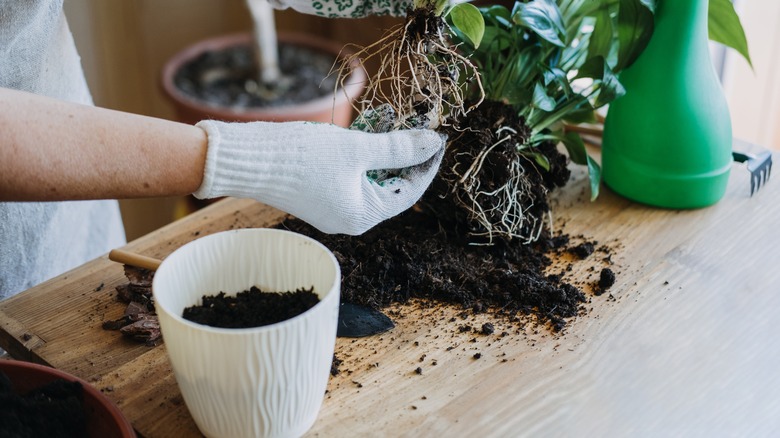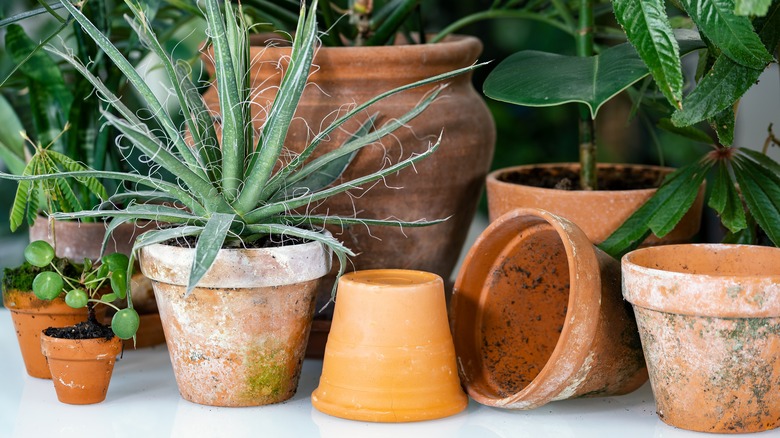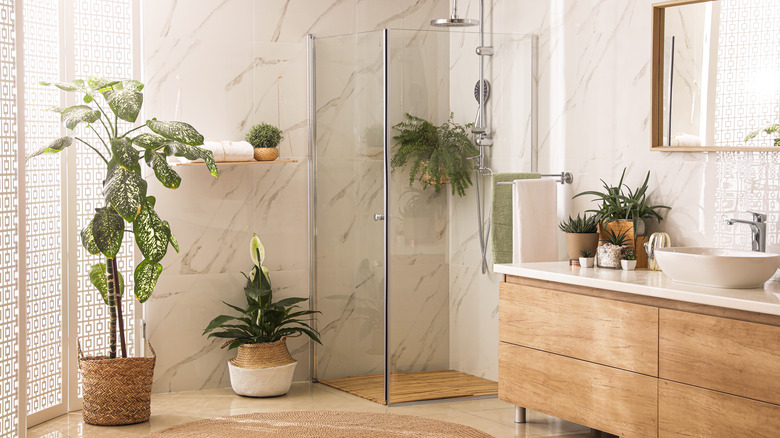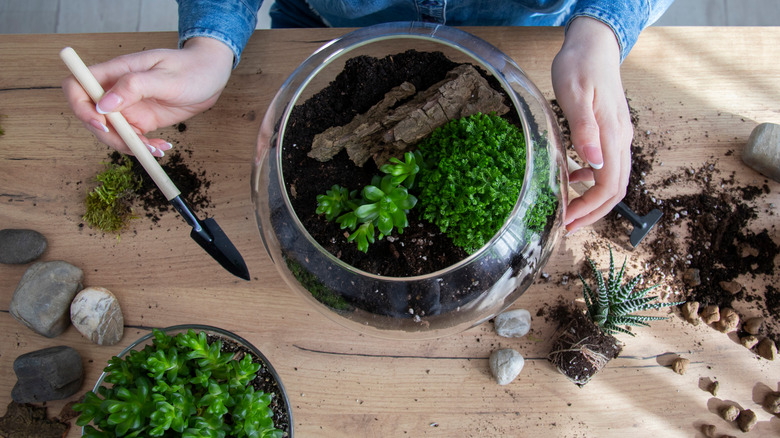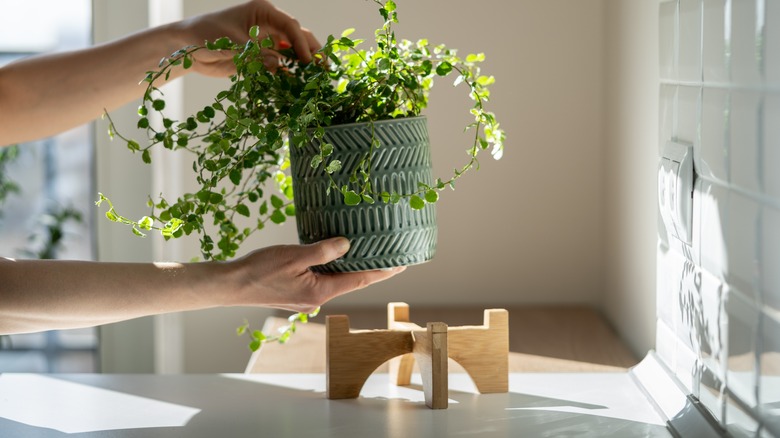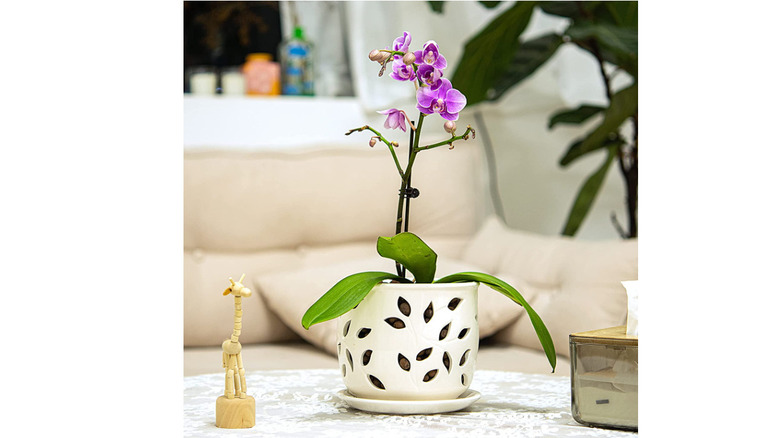5 Best Types Of Planters For Your Houseplants
We may receive a commission on purchases made from links.
Whether you're a sucker for succulents or obsessed with orchids, it is crucial to select the right planter to keep your houseplants growing and thriving. Every houseplant has different growing requirements. Succulents like well-drained soil, while ferns prefer a damp soil environment. The kind of planter you select for each specific plant can either help or hinder its growth, according to the Missouri Botanical Garden. Although you cannot pick a planter solely because it matches your home décor, you can consider your plant's requirements and choose the best option that fits your style.
Healthline says some houseplants may be a little fussy, but working with plants is good for your health. The simple act of repotting and caring for your greenery can help improve your overall well-being, and having plants in your space may even enhance your productivity. To ensure your plants are calming and not adding to your stress, make sure they are in the best planter for their specific needs.
Terra cotta
Terra cotta pots are classic. In any dreamy movie scene set in Tuscany, terra cotta is everywhere and can make a beautiful addition to your home, indoors or out. Unlike plastic, which is comparatively new, terra cotta has been used for everything from the famous Terra Cotta Soldiers on the March in China to creating architectural details in France during the 15th century, according to Dave's Garden. Because terra cotta is made from fired clay, it is naturally porous, making it a good choice for plants that are finicky about wet roots. Houseplants like sansevieria (Dracaena trifasciata) and philodendrons that prefer to dry out between waterings are excellent choices for terra cotta pots. Conversely, plants that like consistently moist soil, like ferns (Tracheophyta) and African violets (Saintpaulia), may struggle in this kind of planter because they dry out too quickly.
Some gardeners consider the patina that terra cotta develops over time an additional benefit to these planters. Although manufacturers try to mimic aged terra cotta, the natural salt and mineral build-up on the outside is part of the charm of an old planter and is harmless, according to Edible Blooms. Of course, if you prefer the look of a fresh clay pot, they are also easy to clean.
Ornamental baskets
Ornamental baskets add natural texture to any space when combined with houseplants. Baskets come in every size, shape, and color, and there are even hanging baskets for plants. Whether your style is traditional, boho, or farmhouse, baskets instead of standard planters can elevate your home's design. Although there are baskets explicitly made for plants, you can use any basket with the proper preparation.
For baskets that are not waterproof, you can leave your plant in its original plastic nursery pot. Eco Anouk suggests placing a saucer at the bottom of the basket to catch any excess water to prevent damage. You can use this process for anything from a small basket to display a string of pearls (Senecio rowleyanus) to a large blanket basket for a fiddle leaf fig tree (Ficus lyrata). Regardless of what kind of plant you use in your ornamental basket, take it out at least once a month to ensure the plastic pot is not holding water, which will lead to root rot.
Terrariums
Terrariums are a lovely way and unique way to display plants. Ambius states there are two types of terrariums: open and sealed. Open terrariums offer some of the benefits of an indoor greenhouse, while sealed terrariums are entirely closed with a lid that can be removed as necessary for maintenance. You can use items around the house to make a terrarium, like an old fish tank, a vase, or a clear storage container with a lid. The key requirement is that the item is clear so your plants can benefit from the greenhouse effect. Beautiful terrariums are also available, like this one on Amazon, if you want to create a stunning focal point in your space.
To use a terrarium for moisture-loving plants, select a sealed option and a peat-based planting medium to keep the soil damp but not soggy. Select plants that do not grow quickly, like button ferns (Pellaea rotundifolia), or carnivorous plants, like Venus flytraps (Dionaea muscipula). Succulents are an excellent option for open terrariums because they grow slowly, and different varieties look lovely when grouped.
Planters with no drainage holes
Some of the prettiest and most unique planters have no drainage, and while that makes them a little more challenging to use, it does not have to be a deal breaker. One benefit to using planters without drainage holes is that they can sit directly on a surface without causing damage to your furniture because of overwatering.
La Résidence states the best way to use a pot without a drainage hole is called staging. This process also involves leaving your plant in its plastic nursery pot but elevating it in the decorative planter to allow for sufficient drainage. Wood or Styrofoam blocks are excellent options to boost your plant. Just take the plastic pot out of the planter to check for standing water at least once a month to prevent issues with mold or pests. If you frequently discover water in the bottom of your planter, you may be watering too often. Reduce the amount and frequency until you notice there is no longer excess water.
Orchid pots
When you buy a beautifully blooming orchid (Orchidaceae), it may come in a decorative ceramic planter without drainage. According to Orchid Bliss, keeping your new orchid in this pot is one of the fastest ways to kill it. In the wild, many varieties of orchids naturally attach to trees where their roots are free to absorb nutrients. Because they require good circulation, a small pot with no holes will lead to rot, according to Gardener's Supply Company. When you bring your new blooming orchid home, care for it according to the instructions that come with it. Then, when it is finished blooming, move it to a planter specifically made for orchids to give it a chance to bloom again.
Orchid planters are unique because they have extra drainage holes on the side. Some are very practical, like this terra cotta option, while others are more ornamental, like this white planter. If you have your heart set on growing your orchid in a basket or a planter without drainage, you can purchase or make a plastic pot with holes on the side. When you repot your orchid, only use a specialty orchid mix, which helps with airflow and drainage.
